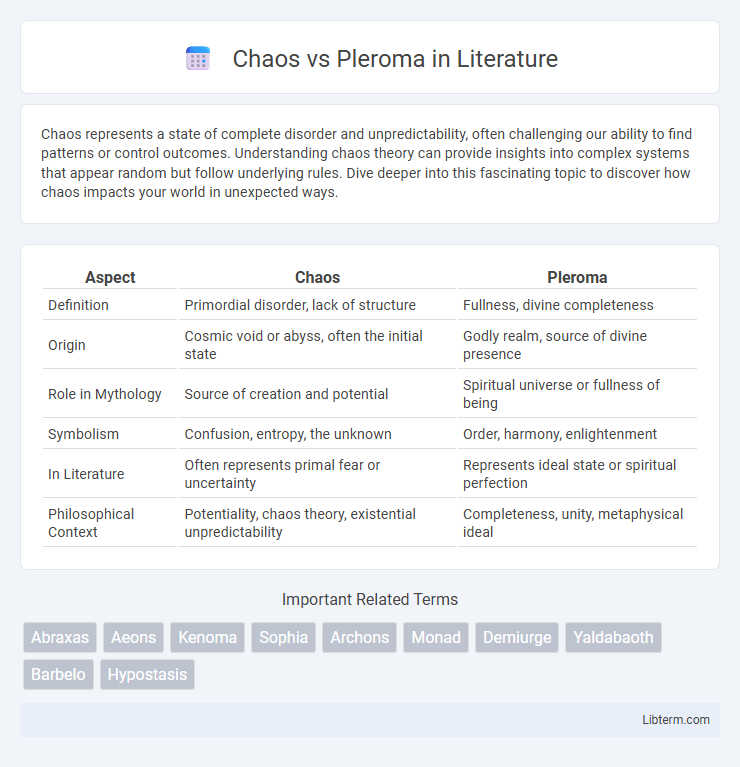Chaos represents a state of complete disorder and unpredictability, often challenging our ability to find patterns or control outcomes. Understanding chaos theory can provide insights into complex systems that appear random but follow underlying rules. Dive deeper into this fascinating topic to discover how chaos impacts your world in unexpected ways.
Table of Comparison
| Aspect | Chaos | Pleroma |
|---|---|---|
| Definition | Primordial disorder, lack of structure | Fullness, divine completeness |
| Origin | Cosmic void or abyss, often the initial state | Godly realm, source of divine presence |
| Role in Mythology | Source of creation and potential | Spiritual universe or fullness of being |
| Symbolism | Confusion, entropy, the unknown | Order, harmony, enlightenment |
| In Literature | Often represents primal fear or uncertainty | Represents ideal state or spiritual perfection |
| Philosophical Context | Potentiality, chaos theory, existential unpredictability | Completeness, unity, metaphysical ideal |
Understanding Chaos and Pleroma: Definitions
Chaos refers to a primordial state of disorder and formlessness often described in cosmology and mythology as the origin of creation or the void preceding existence. Pleroma, derived from Gnostic tradition, signifies the fullness or totality of divine powers and spiritual completeness, representing the ideal state of being or the realm of light and truth. Understanding Chaos as a symbol of potential and Pleroma as a manifestation of realized perfection provides insight into cosmic dualities and spiritual hierarchies.
Historical Roots: Chaos and Pleroma in Ancient Thought
Chaos in ancient Greek cosmogony represents the primordial void or formless state preceding creation, often depicted as an abyss of disorder and potentiality. Pleroma, rooted in Gnostic tradition, signifies the fullness of divine attributes and the spiritual realm of completeness beyond material existence. These concepts reflect dualistic interpretations of the universe's origin, contrasting cosmic emptiness with metaphysical plenitude.
Gnostic Interpretation: Chaos and Pleroma
In Gnostic interpretation, Chaos represents the primal, formless void associated with ignorance and the material world's corruption, while Pleroma signifies the fullness of divine light and spiritual truth embodying the realm of true knowledge and divine beings. Chaos often symbolizes the flawed creation of the demiurge, trapping souls in ignorance, whereas Pleroma is the ultimate source of divine emanations and pure spiritual reality. This contrast underscores the Gnostic quest for liberation from chaos through knowledge (gnosis) that reconnects the soul with the Pleroma's divine fullness.
Philosophical Perspectives on Cosmic Order and Disorder
Chaos represents primordial disorder and the absence of structured existence, symbolizing the unpredictable and formless foundation of the cosmos. Pleroma signifies fullness and divine completeness, embodying the ordered, harmonious state of being within Gnostic philosophy. The interplay between Chaos and Pleroma reflects fundamental philosophical debates on the nature of cosmic order, the origin of existence, and the dualistic tension between chaos as potentiality and pleroma as realized perfection.
Symbolic Representations of Chaos vs Pleroma
Chaos is symbolically depicted as a formless void or primordial abyss, embodying disorder, unpredictability, and the absence of structure, often represented by serpents, darkness, or swirling waters in mythological and philosophical contexts. Pleroma symbolizes fullness, divine completeness, and cosmic order, frequently illustrated as a radiant light, a harmonious sphere, or a divine realm inhabited by aeons in Gnostic traditions. These symbolic representations contrast the chaotic origins of the universe with the ideal state of spiritual plenitude and unity.
Chaos vs Pleroma in Modern Spirituality
In modern spirituality, Chaos represents the primal, formless energy associated with unpredictability and raw creation, while Pleroma symbolizes the fullness of divine light and order. These concepts frame a dualistic understanding where Chaos embodies potential and transformation, and Pleroma denotes harmony and spiritual completeness. Contemporary spiritual practices often explore the balance between Chaos's disruptive power and Pleroma's integrative essence to achieve personal growth and cosmic awareness.
The Role of Chaos in Creation Myths
Chaos often represents the primordial void or disorder from which the cosmos and order emerge in various creation myths, symbolizing the fertile potential for existence. This concept serves as a necessary precursor to Pleroma, the fullness or divine realm, emphasizing the transformative journey from randomness to structured reality. In mythologies like Greek and Gnostic traditions, Chaos embodies the untamed forces enabling creation, highlighting its essential role in the genesis of the universe.
Pleroma: The Concept of Divine Fullness
Pleroma, representing the concept of divine fullness, signifies the totality of divine powers and the spiritual universe in Gnostic cosmology. It embodies the realm of light and completeness where divine attributes and aeons coexist harmoniously, contrasting the void and disorder of Chaos. This fullness is essential for understanding the spiritual perfection and the source of all existence beyond material chaos.
Psychological Reflections: Inner Chaos and Wholeness
Inner chaos represents fragmented thoughts and emotional turmoil, often manifesting as anxiety or confusion, disrupting mental coherence. Pleroma embodies psychological wholeness, symbolizing integration and balance within the self, fostering clarity and resilience. Embracing pleroma enables transformation of inner chaos into a harmonious inner state, promoting mental health and self-awareness.
Reconciling Dualities: Pathways to Integration
Chaos and Pleroma represent opposing cosmic principles--chaos embodies formless void and potentiality, while Pleroma signifies fullness and divine harmony. Reconciling dualities through integrative pathways involves embracing the dynamic interplay, where chaos fuels transformation and Pleroma provides structure and meaning. This synthesis fosters spiritual wholeness by harmonizing disorder with order, enabling transcendence beyond binary oppositions.
Chaos Infographic

 libterm.com
libterm.com